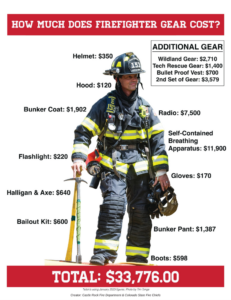Information for Congress
Odd Hours, No Pay, Cool Hat
The National Volunteer Fire Council (NVFC) was pleased to host a Congressional screening of scenes from the volunteer fire service documentary Odd Hours, No Pay, Cool Hat on November 9. To view the full film, use the link and password below:
https://vimeo.com/801859150
Password: FireFilm2023
Learn more about the film at www.oddhoursfilm.com.
View a portion of the panel discussion that took place after the film screening to learn more about the volunteer fire service and the need for reauthorizing the Assistance to Firefighters grant, Staffing for Adequate Fire and Emergency Response grant, and U.S. Fire Administration:
The Volunteer Fire Service
Volunteer firefighters make up 65% of the U.S. fire service and save communities across the country $46.7 billion per year. Most rural and small-town communities rely on volunteers to be their only source of protection from hazards of all kinds. These volunteers respond to structure fires, wildfires, medical emergencies, vehicle crashes, opioid overdoses, lithium-ion battery emergencies, hazardous materials incidents, natural disasters, active shooter situations, and more.
To learn more about the volunteer fire service, check out this fact sheet. You can access additional resources, including the National Fire Protection Association’s (NFPA) Needs Assessment of the U.S. Fire Service, here.
The National Volunteer Fire Council
The NVFC is the leading nonprofit membership association representing the interests of the volunteer fire, EMS, and rescue services, which make up approximately 65% of the nation’s firefighters. The NVFC serves as the voice of the volunteer in the national arena and provides critical resources, programs, education, and advocacy for first responders across the nation.
Reauthorization for AFG, SAFER, and USFA
The authorization for the Assistance to Firefighters Grant (AFG), Staffing for Adequate Fire and Emergency Response (SAFER) grant, and the U.S. Fire Administration (USFA) lapsed on September 30, 2023.
These programs provide critical resources and assistance to the fire and emergency medical service departments that protect our communities. AFG enables departments to obtain the equipment, vehicles, and training they need to do their jobs safely and effectively. SAFER supports recruitment, retention, and hiring efforts so departments have enough staffing to respond to emergencies. USFA is the federal agency that assists the fire service in preparing for, preventing, mitigating, and responding to all hazards.
More information on the value of these programs can be found in the NVFC’s testimony provided to the Research and Technology Subcommittee of the House Science and Space Technology Committee here.
Without these programs, public safety will suffer, leaving communities across the U.S. more vulnerable when disaster strikes. Fire departments responded to more than 36.6 million calls in 2021, and that number grows every year. The cost of equipment and vehicles far exceeds what most departments can afford strictly from local tax revenues and fundraisers like pancakes breakfasts; training requirements continue to increase as community needs grow; and staffing shortages are hitting departments across the nation. AFG, SAFER, and USFA are vital to help offset these challenges and keep communities safe.
 Turnout gear and other personal protective equipment/ clothing (PPE/PPC) along with self-contained breathing apparatus are among the most essential pieces of equipment required to fight a fire, yet according to the NFPA’s needs assessment there is a large unmet need for this equipment. The need for PPE can be found in departments serving communities of all sizes, including one-third of the large departments (protecting a population of half a million or more). Among the smallest departments, 75 percent have at least some PPC that is 10 years of age or older (the maximum that safety standards recommend).
Turnout gear and other personal protective equipment/ clothing (PPE/PPC) along with self-contained breathing apparatus are among the most essential pieces of equipment required to fight a fire, yet according to the NFPA’s needs assessment there is a large unmet need for this equipment. The need for PPE can be found in departments serving communities of all sizes, including one-third of the large departments (protecting a population of half a million or more). Among the smallest departments, 75 percent have at least some PPC that is 10 years of age or older (the maximum that safety standards recommend).
Additionally, according to the NFPA’s needs assessment:
- More than half (57 percent) of all fire departments cannot equip all their responders with wildland fire PPC. This unmet need can be found consistently across departments of all sizes.”
- “More than half (53 percent) of all fire departments cannot equip everyone with SCBA…in addition to lacking SCBA, much of the SCBA in use is 10 years of age or older. More than half of the departments use at least some SCBA equipment that is 10 years of age or older.”
Support for AFG, SAFER, and USFA Reauthorization
Reauthorization for AFG, SAFER, and USFA is the top legislative priority of the nation’s fire service. In addition to the NVFC, reauthorization for AFG, SAFER, and USFA is supported by the International Association of Fire Chiefs, the International Association of Fire Fighters, the National Fire Protection Association, the National Fallen Firefighters Association, and the 34 other member organization of the Congressional Fire Services Institute (CFSI), which can be found here. A recent CFSI press release on AFG, SAFER and USFA reauthorization can be found here.
Status of AFG, SAFER and USFA Reauthorization
The authorizations for AFG, SAFER, and USFA lapsed on September 30. Absent Congressional action, AFG and SAFER face a statutory sunset on September 30, 2024. The Senate’s reauthorization bill (S. 870) passed the Senate 95-2 in April and the House’s reauthorization bill (H.R. 4090) unanimously passed the House Committee on Science, Space, and Technology in June. Unfortunately, further movement on reauthorization legislation has stalled.
The Ask
We ask Congress to pass AFG, SAFER, and USFA reauthorization legislation before December 31.
Contact
For more information or questions, please contact the NVFC’s Chief of Legislative and Regulatory Affairs, Ryan Woodward at Ryan@NVFC.org.



